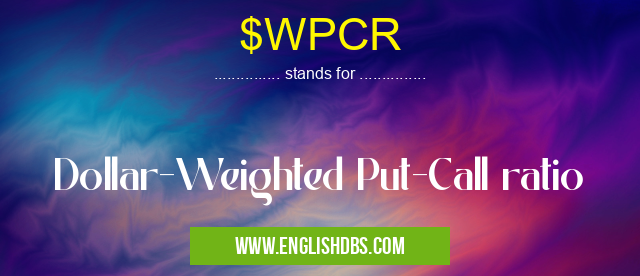What does $WPCR mean in STOCK EXCHANGE
The term $WPCR stands for "Dollar-Weighted Put-Call Ratio". This is a financial metric that can be used by investors to measure the sentiment in the stock market. It is calculated by dividing the total dollar volume of put options by the total dollar volume of call options traded on a particular exchange. The ratio can provide valuable insight into investor sentiment, as higher ratios indicate more bearish sentiment and lower ratios suggest more bullish sentiment. Additionally, changes in the ratio over time may help investors identify potential turning points in the markets.

$WPCR meaning in Stock Exchange in Business
$WPCR mostly used in an acronym Stock Exchange in Category Business that means Dollar-Weighted Put-Call ratio
Shorthand: $WPCR,
Full Form: Dollar-Weighted Put-Call ratio
For more information of "Dollar-Weighted Put-Call ratio", see the section below.
Meaning
The $WPCR is an indicator of sentiment in the stock market and provides investors with an understanding of how much money has been invested in puts versus calls. A high ratio indicates that put options are heavily bought compared to call options, which reflects bearish investor sentiment. On the other hand, a low ratio suggests that there is more bullish activity in the markets as reflected by an increase in buying call options relative to puts.
Calculation
The $WPCR is calculated using total dollar values for both calls and puts being traded on a given exchange or market. In order to calculate this ratio, one needs to take the total dollar value of put contracts divided by the total dollar value of call contracts from that same exchange or market. For example, if a given exchange has $200 million worth of call contracts and $100 million worth of put contracts then its respective WPCR would be 0.5 ($100/$200).
Essential Questions and Answers on Dollar-Weighted Put-Call ratio in "BUSINESS»STOCKEXCHANGE"
What is the Dollar-Weighted Put-Call ratio (WPCR)?
The Dollar-Weighted Put-Call Ratio (WPCR) is a technical indicator that looks at the put to call option volume associated with a particular stock. It compares the dollar amount of traded puts relative to the dollar amount of traded calls over a given period of time, typically 20 days or more. This indicates investor sentiment as well as risk appetite about the underlying stock.
How can I calculate the WPCR?
The WPCR is calculated by dividing the total dollar value of all puts traded during a specific period by the total dollar value of all calls traded during that same period. For example, if $10,000 worth of puts and $20,000 worth of calls are traded in a single day then the WPCR would be 0.5 (10,000/20,000 = 0.5).
What does a high WPCR indicate?
A high WPCR indicates that investors are selling more puts than calls and that they may be concerned about potential downside risks in the near future. This could signal bearish sentiment in the market and suggests that investors are taking protective measures against losses in stock prices.
What does a low WPCR indicate?
A low WPCR indicates that investors are buying more calls than puts which can suggest bullish sentiment in the market and an expectation for rising prices ahead. This could mean that investors are feeling confident about their prospects and expect profits from investing in stocks going forward.
How can I use the WPCR to identify potential trading opportunities?
Tracking changes in the WPCR over time can help identify potential trading opportunities depending on whether it is increasing or decreasing. If it is rising this could suggest bearish sentiment and an opportunity to buy puts as downside protection while a decreasing number suggests bullishness which may suggest buying calls as bets on an upswing in prices.
Is there any difference between Open Interest and Put-Call ratio?
Yes, there is a difference between Open Interest and Put-Call Ratio (also known as Dollar-Weighted Put-Call Ratio or DWCR). While Open Interest reflects open positions - meaning not yet closed out contracts - DWCR relates to how much trading has taken place during one particular session or period when both Puts and Calls were actively bought and sold on any given security. Both provide information regarding activity levels seen among traders but at different points along their investment cycle within their portfolio for options contracts.
Who should pay attention to DWCR?
The DWCR can be useful for any type of trader since it provides insight into investor sentiment surrounding any particular stock or asset class regardless if they trade using options or not due to its implications on general market direction as indicated by directional bias among those who participate in options trading activities such as institutional traders or hedge funds who often use large scale strategies including options strategies such as covered call writes etc..
Is there anything else I should pay attention to with respect to DWCR besides sentiment indicators?
Market volatility should also be considered when looking at changes in DWCR since higher levels tend to lead towards larger fluctuations which potentially leads to greater trading opportunities for experienced traders who understand how these elements interact with each other.
Should I always wait until I see increased levels before initiating trades based off DWCR signals?
There isn't a one size fits all answer here since markets could fluctuate quickly leading traders who act too early into unfavorable positions just shortly after initiating trades based off this indicator so waiting until increased levels have been reached may be beneficial for less experienced traders.
Final Words:
In conclusion, the $WPCR is an important financial metric used by investors to gauge overall market sentiment. Its calculation requires dividing total dollars invested in put contracts versus those invested in call contracts on either a specific exchange or across all exchanges combined. By monitoring changes in this ratio over time, savvy investors can look for potential turning points or price momentum shifts such as bearishness or bullishness becoming dominant themes among traders and investors.
